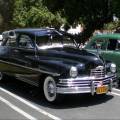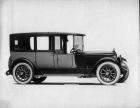|
Re: Standard 8 '49 - oil pressure
|
||||
|---|---|---|---|---|
|
Forum Ambassador

|
Gee, I've never read anything about any "correction factor" in the resistance oil pressure sending unit and would sure like to see the original citation for that. Are you sure you're not thinking of the restriction fitting at the inlet to the oil filter, which is after the oil pressure sending unit?
Posted on: 2008/2/27 21:35
|
|||
|
||||
|
Re: Standard 8 '49 - oil pressure
|
||||
|---|---|---|---|---|
|
Home away from home

|
What the manual refers to is mainline and secondary (tappet) pressure. They don't actually talk about calibrations, but what you have is an oil galley on the right side of the engine that feeds into a smaller bypass cross-channel that feeds the oil filter and tappets. That cross bored bypass is calibrated.
Thus when they talk about normal oil pressure at 45 mph being 40 psi they aren't necessarily talking about pressure at the sender. Packard seemed to like this sort of obfuscation. The earlier manuals drive me crazy with their contradictions. I had this customer come in because his mechanical oil pressure gauge read all over the place while the dashboard gauge was mostly steady. The engine didn't knock when I pushed it up to 40-45 in second. Yet the mechanical gauge says the motor has crummy oil pressure. However at 40-45 mph the mechanical gauge is reading 25 psi while the dashboard reads 30. Next I look in the manual and see "normal oil pressure is 40 psi" but they don't say whether that is mainline or secondary. They only say that less than 20 psi is a problem. Well I do know that the mainline pressure is at least 25 psi because that is what the gauge says. My conclusion here is that the motor passes all of the minimum requirements stated in the manual and that the gauge might as well be an idiot light (it may have had the wrong sender). The purpose of the manual being to diagnose a customer complaint. When I was overseas working for the Air Force they used to bring me these Fords that would have erratic oil pressure gauge readings - zero or middle. Well if the gauge is at zero and the motor isn't clattering it is obvious that the oil pressure is good. You wouldn't believe the trouble I had trying to convince the military that the Ford gauge was calibrated to a default value. That wasn't in any manual.
Posted on: 2008/2/28 20:56
|
|||
|
||||
|
Re: Standard 8 '49 - oil pressure
|
||||
|---|---|---|---|---|
|
Forum Ambassador

|
Especially on Packards of this vintage which didn't come with factory-installed oil filters, one often finds that subsequent owners have removed the pigtail connecting the main galley output to the cross-block galley, and inserted a filter in series with that galley. Lousy idea because (1) the filter input has a flow restrictor, and (2) if the filter plugs, you essentially cut off the oil flow to the lifters. Not too bad if you have mechanical lifters because prior to 1938 the small 8 only used mist lubrication for the lifters anyway, but with a later engine with hydraulic lifters the consequences will be expensive.
Posted on: 2008/2/28 23:31
|
|||
|
||||
|
Re: Standard 8 '49 - oil pressure
|
||||
|---|---|---|---|---|
|
Not too shy to talk

|
My 288 with 30W oil has showed a little over 30 lbs. since I've had it. It is steady at 30 no matter what RPM from idle up so it too could be slightly inaccurate from age. Since it certainly does go down when you shut off the engine it is still useful to watch in any case.
Posted on: 2008/3/5 15:53
|
|||
|
||||
|
Re: Standard 8 '49 - oil pressure
|
||||
|---|---|---|---|---|
|
Home away from home

|
Packard recommended straight 30 weight. I have had much better (consistent) results with it than multivis oils. We typically use our cars in the summer and my pressure is more consistent from start to warm.
I agree if your pressure doesn't drop below 10 at idle you should be fine. This lower pressure at idle than at slow cruising speed usually indicates worn cam bearings.
Posted on: 2008/4/5 19:54
|
|||
|
||||









